|
|
| 1. |
Place the Software
Installation Disc for the Windows platform into the disc drive. After a
few seconds, the installation program is launched.
If the installation program does not launch automatically:
- Click the Start button on the Windows task bar, and then click Run.
- Browse to the installation disc drive, select Setup.exe, click Open, then click OK.
NOTES
- If you are installing on Windows Server Core editions, mount to Software
Installation Disc through command line, go to the AMD64 folder and run
Setup.exe.
|
| 2. |
Choose the language you want to use during installation.
Click the down arrow and select the desired language from the drop-down list, and click Next to continue.
|
 |
| 3. |
Select the option to install software on this computer. NOTES
- The options that appear on this screen depend on the computer in which
the software is being installed.
|
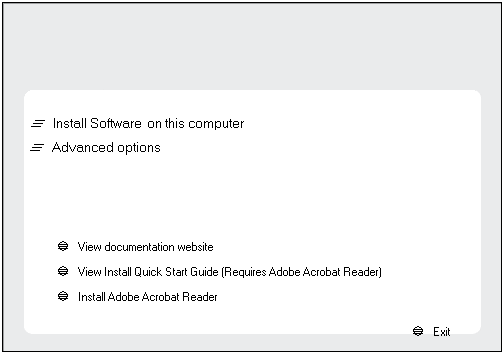 |
| 4. |
Read the license agreement, then select I accept the terms
in the license agreement. Click Next to continue.
|
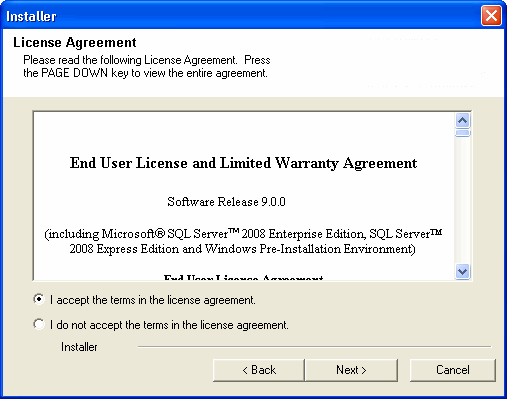 |
|
|
| 5. |
Select the component(s) to install. NOTES
- Your screen may look different from the example shown.
- Components that either have already been installed, or which cannot be installed, will be dimmed.
Hover over the component for additional details.
- If you wish to install the agent software for restore only, select
Install Agents for Restore Only checkbox. See
Installing Restore Only Agents for
more information.
- The Special Registry Keys In Use field will be highlighted when GalaxyInstallerFlags
registry key is enabled. Move the mouse pointer over this field to
see a list of registry keys that have been created in this computer.
Click Next to continue.
To install the Lotus Notes Add-In Client, expand the
Client Modules
folder, and the Archive Management folder,
then select the following:
- Lotus Notes Add-In Client
|
 |
| 6. |
Click YES to install Microsoft .NET Framework
package. NOTES
- Follow the on-screen prompts for installing the Microsoft .NET
Framework package.
- If you are prompted to install the Service Pack for the
Microsoft .NET Framework, click Yes.
- This prompt is displayed only when Microsoft .NET Framework is
not installed.
- Once the Microsoft .NET Framework is installed, the software
automatically installs the Microsoft Visual J# 2.0 package.
|
 |
| 7. |
Click Yes to install the Java Runtime Environment (JRE) or click No
if you would like to use the JRE Version already available in your computer.
NOTES
- This prompt will be displayed only if the computer is running a JRE
version prior to the one supplied in this installation program or no JRE version is available at all.
See
System Requirements
- CommServe for more information on JRE versions.
|
 |
|
|
| 8. |
If this computer and the CommServe is separated by a firewall, select
the Configure firewall services option and then click Next to
continue.
For firewall options and
configuration instructions, see
Firewall Configuration
and continue with the installation.
If firewall configuration is not required, click Next to continue.
|
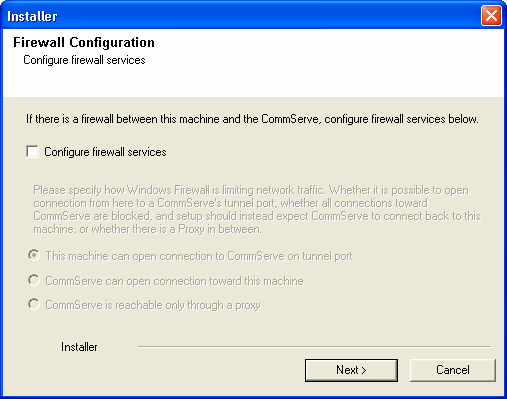 |
| 9. |
Enter the fully qualified domain name of the CommServe Host Name. This should be
TCP/IP network name. e.g., computer.company.com. NOTES
Click Next to continue.
|
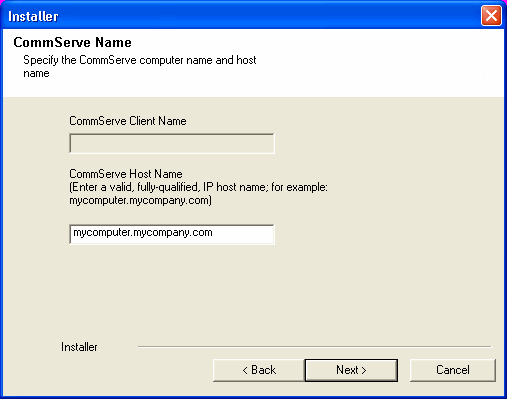 |
| 10. |
Enter the username and password associated with an external
domain user account or a CommCell user account to authorize the installation
of this agent. NOTES
- This window will be displayed when the Require Authentication for Agent
Installation option is selected in the CommCell Properties. For more
information, see
Authentication for Agent Installs.
Click Next to continue.
|
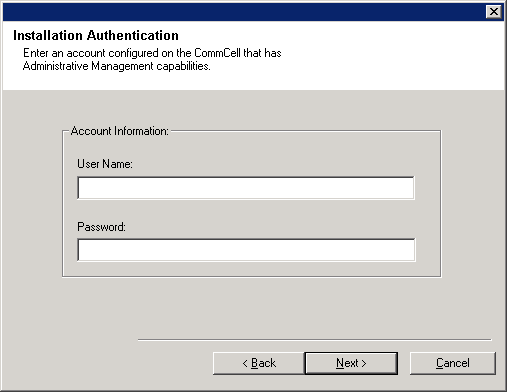 |
| 11. |
Enter the following:
- The local (NetBIOS) name of the client computer.
- The TCP/IP IP host name of the NIC that the client computer must use to communicate with the CommServe
Server.
NOTES
-
Do not use spaces when specifying a new name for the Client.
- The default network interface name of the client computer
is displayed if the computer has only one network interface. If the
computer has multiple network interfaces, enter the interface name that
is preferred for communication with the CommServe Server.
- If a component
has already been installed, this screen will not be displayed; instead, the
install program will use the same name as previously specified.
Click Next to continue.
|
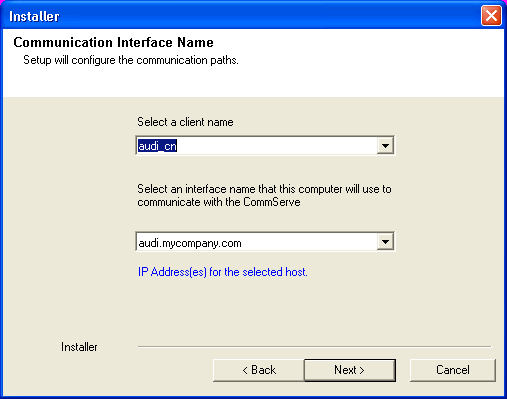 |
| 12. |
Select Add programs to the Windows Firewall Exclusion List, if
you wish to add CommCell programs and services to the Windows Firewall
Exclusion List.
NOTES:
Click Next to continue.
|
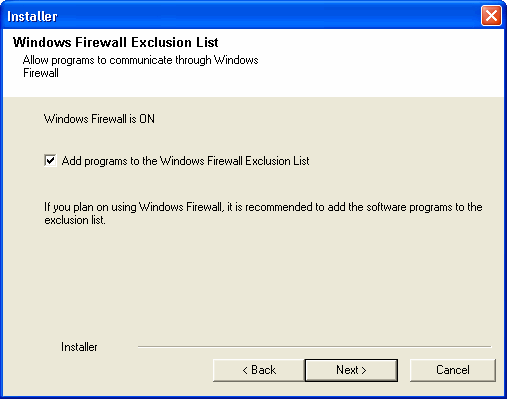 |
| 13. |
Specify the location where you want to install the software. NOTES
- Do not install the software to a mapped network drive.
- Do not use the following characters when specifying the destination path:
/ : * ? " < > | #
It is recommended that you use alphanumeric characters only.
- If you intend to install other components on this computer, the selected installation directory will be automatically used for that software as well.
- If a component is already installed in this computer, this screen may not be displayed.
The software will be automatically installed in the same location that was
previously specified.
Click Browse to change directories.
Click Next to continue.
|
 |
| 14. |
Provide the fully qualified host name of the Domino Server. |
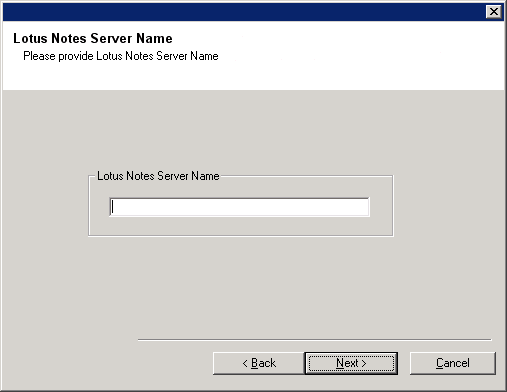 |
|
|
| 15. |
Verify the summary of selected options.
NOTES
- The Summary on your screen should
reflect the components you selected for install, and may look different from
the example shown.
Click Next to continue or
Back to change any of the options.
The install program now starts copying the software to the computer.
This step may take several minutes to complete.
|
 |
|
|
| 16. |
Setup displays the successfully installed components.
NOTES
- The Setup Complete message displayed on
your screen will reflect the components you installed, and may look different
from the example shown.
- If you install an Agent with the CommCell Console open, you need to
refresh the CommCell Console (F5) to see the new Agents.
- If Reboot Now button is displayed make sure to reboot the
computer before performing any other operations from the computer.
Click Finish to close the install program.
The installation is now complete.
|
 |
General
|














